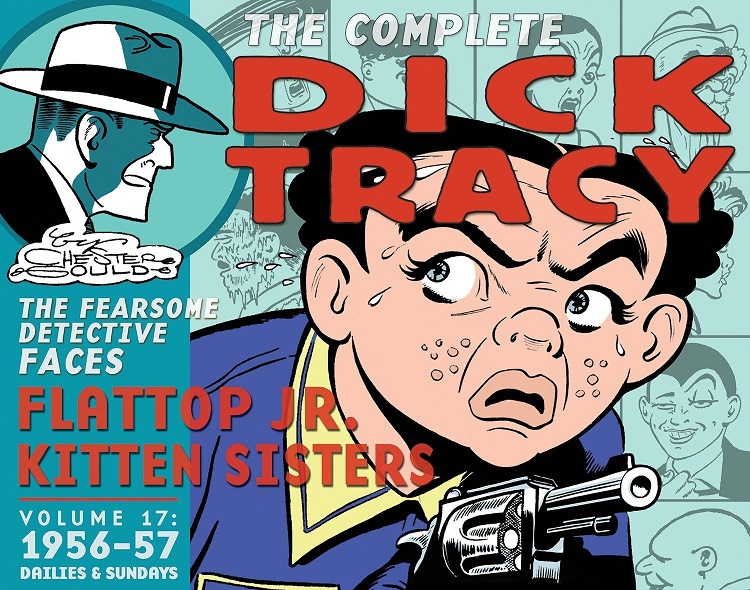
The Library of American Comics and IDW Publishing are publishing The Complete Dick Tracy by Chester Gould. Volume 17 is their latest release and it collects the dailies and Sunday strips from May 14, 1956 through to December 14, 1957. Dick Tracy would reach its 25th year on October 4, 1956, and Gould showed no signs of losing the strips’ high standards.
The book opens with Joe Period and Flattop Jr. in hiding from crimes readers witnessed in Volume 16, but rather than running away, they head back to town because Joe seeks revenge against “Nothing” Yonson, who tried to have him killed. When Yonson sees Joe mentioned in the newspaper, he barricades himself in his restaurant office and stations men outside. Meanwhile, Tracy and his team discover Joe’s plan and set up surveillance around Yonson’s.
Gould’s plotting is engaging. There are multiple storylines converging together, and while it is expected Tracy and the good guys will triumph, the resolution isn’t simple, urging the reader onto the next panel. However, during the story’s denouement, Joe’s mother shows up and is so melodramatic as she bemoans her poor parenting being the cause of Joe’s fate she comes across like the voice of the author rather than a believable character.
Flattop escapes. He rents a room and poses as an art student. The landlord’s daughter, Skinny, takes a great interest in him and his work. She submits a painting to a contest without his knowledge, which draws the attention of Tracy’s co-worker policewoman Lizz Worthington.
While Flattop flees the cops, Gould draws a ghostly figure harassing him. At first, it seems to be a metaphor of Flattop’s guilty conscious like Poe’s “The Tell-Tale Heart,” but later Gould reveals it to actually have been a ghost. This seems like a very odd choice because it begs the question why none of the other murder victims haunt their killers in this book or the previous volume I read.
This volume contains four other cases. Spec, a young mute girl shoots a stick-up man and leads Tracy to a counterfeiting ring. The best part of this story the criminals turning on each other when it looks like they are about to get caught and one gets sent to the sharks. A ski-jumper killed mid-flight by an arrow leads to the case of the dangerous Kitten Sisters, which sees the return of Spike Jonze stand-in, Spike Dyke.
Morin Plenty, father of B.O., and his wife Blossom come to town looking for help to patent an adjustable shoe heel. These comic-relief characters come off more odd than anything else, as she is always barefoot, seems young enough to be his granddaughter, and has a strange diet of sweets. Things go from silly to serious when the Clipso Brothers try getting involved in Plenty’s business. Gould teases readers by ending one strip with a panel where Tracy gets shot square in the head but inexplicably survives. The last case involves Claude Crystal, who embezzled $200,000, but it’s his wife chilly disposition that drives the crime and story.
Gould’s line and ink work continue to impress in this volume. Many panels are filled with great background details that bring the locations to life. In the Kitten Sisters story, he uses a lot of snowflakes in the atmosphere. Gould also draws fine textures in the characters’ clothing. His use of shadows and darkness help set the mood.
Max Allan Collins, who took the strip when Gould retired, writes an introductory essay critiquing the stories contained within the book, and historian Jeff Kersten of The Chester Gould/Dick Tracy Museum provides informative background about Gould and the strip in his essay that concludes the book.
Whether continuing to read Dick Tracy or discovering the strip for the first time, Volume 17 delivers entertaining, action-heavy crime dramas. The only negative is the lack of the good guys’ character growth but the intriguing stories and the fast pace that they are told give readers little time to pause and notice because of the interest created in finding out what comes next.